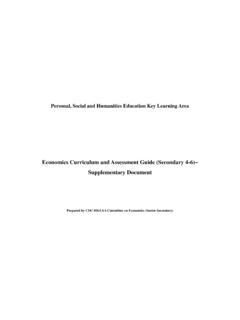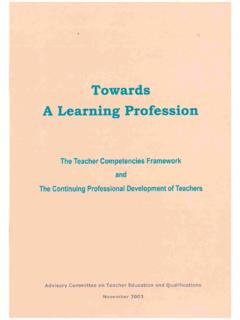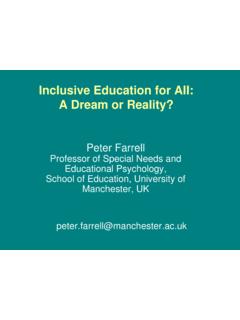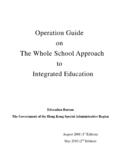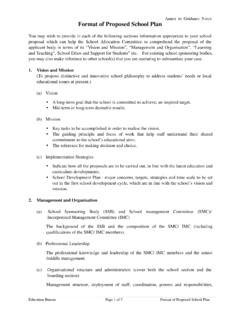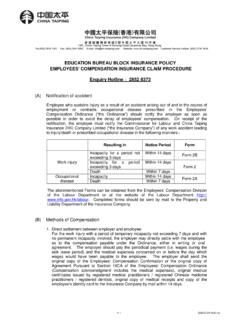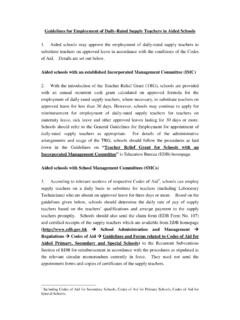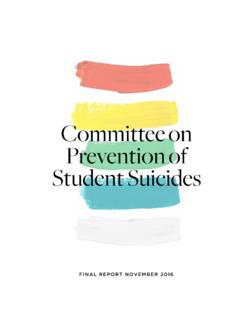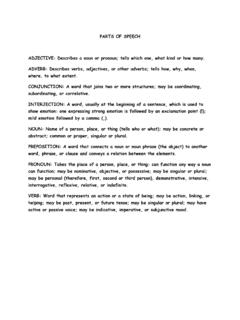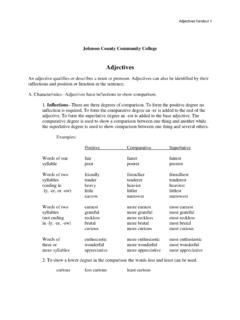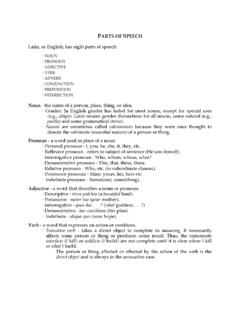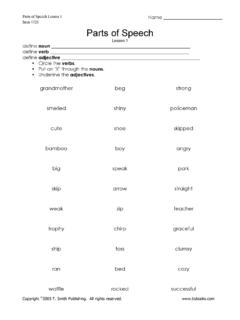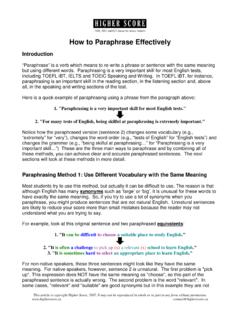Transcription of Basic English Sentence Patterns - edb.gov.hk
1 CONTENTS Unit 1 Basic English Sentence Patterns 1 Unit 2 parts of speech 7 Unit 3 Simple Present Tense 23 Unit 4 Simple Past Tense 37 Unit 5 Present Perfect Tense 51 Unit 6 Simple Future Tense 59 Unit 7 The Passive Voice (Simple Present Tense) 69 Unit 8 The Passive Voice (Simple Past Tense) 79 Unit 9 Agreement between Noun and Verb 93 Unit 10 Prepositions 105 Unit 1 Basic English Sentence Patterns A.
2 When we make simple English sentences, we usually follow the Subject-Verb-Object pattern. Steps: 1. put the subject and the adjectives such as fat , thin etc. or any words describing the subject at the beginning of the Sentence 2. put the verb and some adverbs such as often , usually etc. after the subject 3. put the object of the verb, the adjectives or other words describing the object and the adverbs describing the verb at the end of he Sentence Subject Verb Object Paul Mary My father and mother The fat girl That little boy often eats ate are eating has eaten will eat biscuits.
3 Two apples quickly. mangoes now. a watermelon. some bread soon. Exercise 1 Rearrange the words in correct order to make complete sentences. the fat cat / a mouse / is chasing. The fat cat is chasing a mouse. 1. that thin girl / is drinking / milk now 2. the robbers yesterday / the police / caught 3. our teacher / like /we 4. my mother / my baby sister / is looking after 5. has just written / a letter / the tall man 6. the students / have solved / some Mathematics problems 7. her aunt tomorrow / will visit / Mary 8. newspapers every day / my boss / reads 9. enjoyed / the movie / the audience 10. the cook / some chocolate cakes / has made 1 Answers Exercise 1 1.
4 That thin girl is drinking milk now. 2. The police caught the robbers yesterday. 3. We like our teacher. 4. My mother is looking after my baby sister. 5. The tall man has just written a letter. 6. The students have solved some Mathematics problems. 7. Mary will visit her aunt tomorrow. 8. My boss reads newspapers every day. 9. The audience enjoyed the movie. 10. The cook has made some chocolate cakes. 2 B. Some verbs can be followed by two objects without an and connecting them. One of these objects is called the direct object and the other the indirect object . Below is the pattern of a Sentence containing both direct object and indirect object: Subject Verb Indirect Object Direct Object Subject Verb Indirect Object Direct Object I My parents We They gave always tell have lent are asking my sister me him the teacher a birthday present.
5 Stories. some money. some questions. Exercise 2 Rearrange the words in correct order to make complete sentences. my sister / a birthday cake yesterday / me / baked My sister baked me a birthday cake yesterday. 1. the short man / has bought / some crayons from the stationery shop / his son 2. the policeman / has just shown / the driver / his driving license 3. the patient / gave / some medicine / the nurse 4. brought / me / a bouquet of flowers last week / my uncle 5. the shopkeeper / the customer / is paying / two hundred dollars 6. he / his brother / the secret / has never told 7. a postcard from Japan / sent / her / her best friend 8.
6 Did not lend / his new model car / the child / his classmate 9. her mother / cooked / her / some congee 10. has ever given / any help / the blind woman / no one in the street 3 Answers Exercise 2 1. The short man has bought his son some crayons from the stationery shop. 2. The driver has just shown the policeman his driving license. 3. The nurse gave the patient some medicine. 4. My uncle brought me a bouquet of flowers last week. 5. The customer is paying the shopkeeper two hundred dollars. 6. He has never told his brother the secret. 7. Her best friend sent her a postcard from Japan. 8. The child did not lend his classmate his new model car.
7 9. Her mother cooked her some congee. 10. No one in the street has ever given the blind woman any help. 4 C. Sometimes a preposition is put in front of the indirect object. The pattern of such Sentence is : Subject Verb Direct Object Preposition Indirect Object Subject Verb Direct ObjectPrepositionIndirect Object My friend His parents has sent bought a letter a computer to for me. him. Exercise 3 Rewrite each of the following sentences by placing the word in brackets before the indirect object. My brother showed me his new wallet. (to) My brother showed his new wallet to me.
8 1. The postman took her a letter yesterday. (to) 2. The dog owner gives his dog a bone every day. (to) 3. The students sent their teacher a present. (to) 4. The gardener handed me some flowers. (to) 5. My mother has already taken my father a cup of coffee.(to) 6. She found me a seat in the concert last Sunday. (for) 7. Betty has painted her best friend a beautiful picture. (for) 8. We bought our uncle a pair of gloves on his birthday. (for) 9. The tailor made the princess a new dress. (for) 10. Judy has baked me some chocolate cookies. (for) 5 Answers Exercise 3 1. The postman took a letter to her yesterday. 2. The dog owner gives a bone to his dog every day.
9 3. The students sent a present to their teacher. 4. The gardener handed some flowers to me. 5. My mother has already taken a cup of coffee to my father. 6. She found a seat for me in the concert last Sunday. 7. Betty has painted a beautiful picture for her best friend. 8. We bought a pair of gloves for our uncle on his birthday. 9. The tailor made a new dress for the princess. 10. Judy has baked some chocolate cookies for me. 6 Unit 2 parts of speech Words perform different functions in a Sentence . Details are as follows: parts of speech Usage Example Noun it names a person, a place or a thing Mary is beautiful.
10 Paris is the capital of France. Freedom is very important. Pronoun it is a word used instead of a noun They are good students. The pencil is hers. Adjective it describes a noun My father is tall but my mother is short. Ver b it tells an action Birds fly. Adverb it describes the adjective and / or verbs The children always talk loudly. Preposition it tells the relationship between nouns / pronouns and other words in a Sentence My parents will meet me at the station tomorrow. Conjunction it joins sentences, clauses, phrases and single words Jimmy opened the door and went in. Exclamation it tells sudden feeling or emotion Hurrah!
